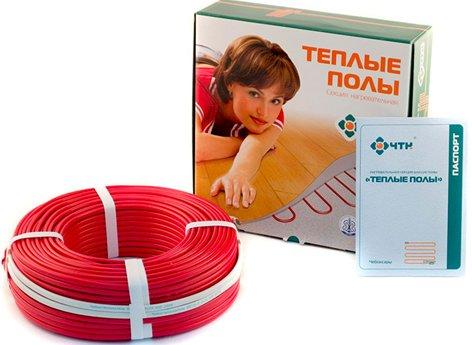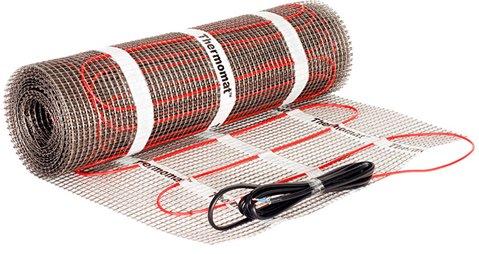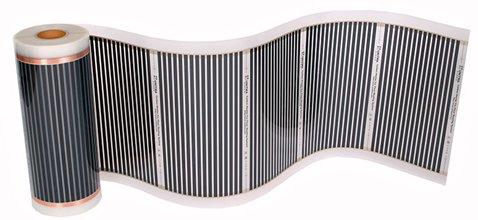Modern warm floors are represented by a fairly diverse system, which could gain high popularity among domestic consumers. Today on the market you can find a solid assortment, and even at an affordable cost, which only pleases buyers. In view of this, it is often necessary to get an answer to the question of which warm floor to choose.
Realizing this fact, we decided to give an answer to it in an expanded form. From the article you can find out which floor heating system can be installed in a private house or apartment, why it should be preferred. At the moment there are several types of floors. These are electrical and water systems. Each of them has a number of modifications and varieties, which will also be mentioned in the article.
Content
- 1 List of manufacturers of underfloor heating: which brand to give preference to
- 2 What kind of warm floor to choose under the tiles
- 3 Types of warm floors
- 4 Film warm floor: which option to choose
- 5 Choosing a floor heating system for porcelain stoneware
- 6 The main purposes of heating
- 7 Determining the power parameter
- 8 Renovation work
List of manufacturers of underfloor heating: which brand to give preference to
If you do not want to delve deeply into the question of how to choose a warm floor, do not seek to study its features, then you can recommend turning to the eminent collection of the available assortment of brands that are engaged in their production. We analyzed the information on the Web, read the comments of experts and users when we compiled a list of leading companies. Other brands are Hemstedt, Devi, Gray Hot Heating, Ratey and ProfiTherm.
What kind of warm floor to choose under the tiles
The main property of ceramic tiles is their high thermal conductivity capabilities. For this reason, floor coverings are considered "cold". The situation became radically different when a number of warm floors appeared, which have the ability to heat up to the desired temperature.
But keep in mind that choosing a system for ceramics is not so easy. There are a number of important factors to consider. First of all, decide what kind of heating you decide to equip, whether the warm floor will act as the main one or is it additional.
In the case of the first option, the system will occupy less than 70 percent of the entire area, but the heating elements will be located at a fairly close distance to each other. If we take the second option into consideration, then there will be no restrictions, the configurations are very different, and the area can be any. As a rule, heating of an additional type is often used to equip a bathroom, corridor or other places where there are floors made of tiles. Such a duet, which consists of traditional batteries and a warm floor, is usually used only in a private house or apartment. It will act as an addition to heating in the winter.
Dealing with the question of which option is better to choose, keep in mind that all systems are different. We will talk about this below.
Types of warm floors
All types of underfloor heating today are usually divided in view of the source of the type of heating and heat. There are 3 main varieties. Let's talk about their pros and cons a little below.
Water floor

Quite a lot of people decide to choose a water-heated floor for arranging their place of residence. The design is made on the basis of flexible pipes made of metal-plastic.Professionals lay them in the form of a spiral or a snake, and then they are poured with concrete. Such devices need a boiler, pump, fitting and collectors. If the installation is done incorrectly, then the operation will not be effective, since the coolant is also cooling down. A suitable option for the decoration of private houses. Due to the water floor, you can equip the main heating, as well as additional.
The advantages include the affordability of the system, but this is possible if a pump and a boiler are already available. The cost and water is inexpensive, suitable for use and under any other type of flooring. The system will serve for a really long time, without upsetting its owner with breakdowns. The work can be presented in the form of a main or auxiliary element, when the water supply to the room is cut off using a tap.
But the disadvantages are that you cannot put the system on your own, and it is quite difficult to repair it. Operation is impossible if there is no pump, and it is not customary to use the water floor for the arrangement of apartments, where it is prohibited to connect to central heating. This is also an inappropriate option for rooms that have low ceilings.
Electric floor

Another type of underfloor heating, which is laid out on the basis of a cable. It must be laid in a concrete screed. Also, the base can be a layer of glue under the topcoat. An option is suitable for decorating floors in houses, apartments, country houses. It can be used both as main and additional heating. In the bathroom and in the kitchen, this is a very practical option, and therefore it is not surprising that the electric floor is so in demand among consumers in our country.
Among the advantages is the fact that this type of floor is able to serve for a really long time. It will not consume a lot of electricity, and therefore there is no need to fear for colossal utility bills. The system has high plastic properties, it bends easily, and therefore is suitable for laying under any turn in the room. Temperature control is as smooth as possible.
Speaking of the disadvantages, we can mention that the system needs to increase the height of the floor, the formation of electromagnetic radiation is also observed in the room. This option is not suitable for parquet or laminate flooring, and the installation work is very long in the case of concrete pouring.
Film infrared floor

A version of a thin carbon film is presented, which has connections with contacts with flat wires of a linear type. When energized, the carbon paste emits infrared radiation. Rolls can be cut in special places, while it is imperative to maintain a step of 25 centimeters. Suitable option for equipping bathrooms, nurseries and loggias, where they can be used as auxiliary heating.
The advantages of this type include the presence of a varied assortment in the collection, as well as the ability to interact with different types of topcoats. The repair will not be accompanied by difficulties, if such is required. Access to works is easy. Often, the floor height will not be raised when arranging the system. Part of the film will function even if there have been cases of damaged contacts. Please note that it is possible that you will need to relocate to another place.
But the disadvantages are that during installation, you need to be as careful as possible and test the entire system for integrity. Please also note that this option is not always suitable as additional heating.
Film warm floor: which option to choose
Very often, owners of their own homes are faced with the question of choosing a warm infrared floor. You need to correctly determine the option, but in order to do this, you should learn about the main advantages of the system.
So, consider the physical properties of the infrared wave. It is about 5-25 microns in length. It only heats the surfaces without affecting the air that is present in the surrounding space. As a result, the microclimate in the room can be maintained at an optimal level, without the need to use different types of humidifiers.
The surface of the floor itself will be warmed up over the entire area, evenly distributing the temperature over the area of the entire room. Those. division into cold and hot zones is not provided. The action time is short. The heating effect is present a couple of minutes after turning on the system itself. Air temperature will have the same value at all levels. These installations have very compact dimensions, and therefore, after installation, the floor level will not rise higher than 3 centimeters.
In fact, film floors can be called the most economical when compared to other systems. The thing is that their electricity consumption is 20 percent less. Yes, they obviously have a lot of advantages, but keep in mind that the infrared floor also has disadvantages.
The disadvantages are associated with the fact that the installation of the structure is complicated. Everything is not as smooth as sometimes comes from advertising blocks of building materials. When working, you need to be as careful as possible, take precautions. Any incorrect installation can damage the contact, as well as the connection, and this will lead to the need for additional costs.
There are also a number of restrictions in accordance with the choice of furniture that can be placed on this type of floor. The film is presented today as carbon and bimetallic, in view of the components that are used in the design. In the first case, a carbon paste is used, presented in the form of carbon fiber. The material must be sealed in 1 layer of lavsan film. Some modifications involve the application of graphite spraying to the carbon fiber area. The system is used with a number of floor coverings, not an exception is porcelain stoneware and tiles.
In the case of a bimetallic structure, aluminum and copper plates are used, which are located between an elastic-looking polyurethane film. The option is appropriate for flooring, and the tile was no exception.
Choosing a floor heating system for porcelain stoneware
Even in the recent past, porcelain stoneware was not widely used in premises where people live on a permanent basis. This was due to the fact that the material is usually referred to as cold. Only when it became known about the advantages of the underfloor heating system, the situation took a different turn. This material has become a heat source.
To date, there is an understanding that underfloor heating is presented in the form of a specific layer, which is located between porcelain stoneware and a concrete base. Warm floors under porcelain stoneware can be used in electric or water version.
Water floors are presented in the form of a metal-plastic pipe, which has a heat carrier and is passed under the porcelain stoneware. The disadvantage is that there is a complete dependence of the water temperature on the one that circulates in the general flow system. Cracks in the area of the pipes will lead to flooding of the lower section of the floors. To carry out repair work, you will need to worry about removing the entire porcelain stoneware coating.
Installation of electric underfloor heating is much more affordable and faster than the option above. The temperature mode can be regulated by the thermostat, reaching the desired value. This will eliminate the cost of electrical energy.
The main purposes of heating
The choice of a floor heating system also depends on what its main purpose will be during use. If you want to replace the main heating with radiators, then the system must be located in the rooms. It will be practical to put reinforced-plastic pipes under the area of the concrete screed. Gas and water are cheap and affordable substances, and therefore it is possible to heat a living room due to them.Practical solution for the private sector.
If the goal is to warm up a room from time to time for use, for example, a loggia or a balcony, then it is better to stop your decision on the installation of IR film. It heats up quickly, giving warmth. For a summer cottage, you can buy an electrical system made of cables. This will charge the area with thermal energy, warm it up. In this case, the installation of a boiler with a pump is optional.
Determining the power parameter
The criterion is important. The maximum temperature and the rate of heating of the entire room depend on it. If you are comfortable at 20-24 degrees, or if the house has a second heating, then you can choose systems with an indicator of 110 W / kW m. Due to this, the temperature will be very comfortable, and it will be possible to save electrical energy.
All lovers of warmer conditions should look for a system whose parameters will be 150-170 W / kV.m. This is a practical solution for loggias, bathrooms. Those. you will not freeze there, even if the deep autumn season comes, when the centralized heating in our country is in no hurry to turn on the city authorities.
Indicators are more than 220 W / kV.m. make it possible to replace heat from standard batteries. They can be suitable for arranging an apartment or when deciding to refuse to use the services of a central heating system altogether.
Renovation work
Typically, the average lifespan of a floor heating system is 15-20 years. But this does not mean that nothing will happen to them during this time. If the system fails, then repair is indispensable. You can get to the heating elements, but keep in mind that the difficulty level will be high. The easiest way is to repair the film floor, which is located under the area of the laminate or parquet.
If you lift the linoleum, the segment replacement can be easily done. It is also convenient if you need to replace the contact. The infrared floor system will not stop functioning, even if there is a disconnection in the strips, both one and several. This is due to the fact that the voltage is supplied to the lines separately.
With water or cable floors, which are laid in a concrete screed and covered with ceramic tiles on top, you need to deal with the parsing of the finishing layer, breaking the concrete in the problem area. For example, this is necessary when a pipe is flowing, a cable break is observed. But do not be alarmed, such cases are extremely rare, because the protection of the system from mechanical damage in the floors at a depth is quite high.



